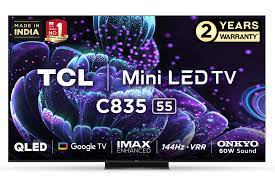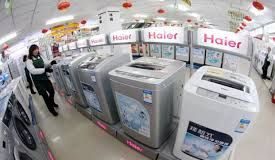TCL India is likely to remain one of the largest producers of flat glass panels and home appliances
In India, the company is headed by Philip Xia (Xia Dongyue), CEO of TCL India. He embarked on his journey with TCL in 2006 and later took on the responsibility of steering the company’s growth. Notably, he spent a remarkable 11 years in the Philippines, during which he orchestrated TCL’s ascent to become a dominant force in the retail market segment.
In conversations with Dominic Rebello and RN Bhaskar, (both from the Free Press Journal) Philip delves into the blueprint of TCL India’s prospective endeavors. He sheds light on his attempts to comprehend the intricate dynamics of the Indian market, all in pursuit of realising the company’s goal of achieving a notable 10% market share of the Indian market.
How big is TCL? Can you tell us something?
How do I express the extent of its size? This is because TCL is not solely focused on the TV industry; it also encompasses home appliances. We are akin to brands like Haier, which are recognized for their elevated status. Our scope extends beyond the panel business; we are engaged in producing not only televisions but also refrigerators, air conditioners, and various other home appliances. This actually represents just a single facet of TCL Group’s diverse business portfolio.
In fact, our conglomerate encompasses various other sectors. We have a communication group responsible for laptops and mobile phones, a solar power division dedicated to renewable energy solutions, and even a finance department. The expanse of our group is vast, with distinct branches thriving in different industries. This multifaceted approach allows us to span across multiple sectors.
Furthermore, we are proud to be associated with the semiconductor field through a joint venture situated at Tianjin in China. Remarkably, we currently hold the top position, dominating the market in China’s semiconductor industry. TCL Group stands as a substantial entity, reaching far beyond the domain of home appliances.
TCL has made substantial investments in manufacturing operations within India. Specifically, these investments focus on producing panels, which we often refer to as “open Cell” or glass panels. These panels are integral components of televisions.
How big is the TCL Group?
On a year-to-date basis, the TCL group reported consolidated revenues from continuing operations of $1.1 billion, which was eight per cent higher than 2022. In terms of stock value in China, I believe it is approximately USD 20 billion. However, I’m not entirely certain about the accuracy of this figure.
Are the TCL computers that are seen in shops imported?
I’m not entirely certain, as I mentioned earlier, our division falls under the home appliances group. The realm of computers and laptops falls within the domain of the communication group. They operate through a subsidiary in India, and it’s possible that these products are imported by their team rather than ours.
So you look after air conditioners, washing machines and TV panels…
I only look after washing machines and television panels.
Does panels mean the machinery that goes inside the box, or is it the screen?
Allow me to provide some clarification. TCL has made substantial investments in manufacturing operations within India. Specifically, these investments focus on producing panels, which we often refer to as “open Cell” or glass panels. These panels are integral components of televisions.
However, I want to emphasise that the production of screens used in monitors does not fall under my department’s jurisdiction. This responsibility lies with a distinct group within our organization. They handle this aspect through a separate division.
Regarding the panel manufacturing, our company made a significant investment of approximately $130 million in a third-party factory named CSOT. This factory has since risen to prominence and is now ranked among the world’s top two panel manufacturers. The other prominent manufacturer in this domain is BOE, also based in China. Notably, both of these leading panel manufacturing companies are situated in China. CSOT is under the umbrella of TCL.
The investment of $130 million has been channeled into the panel manufacturing facility located in Tirupati in south India. This factory has been operational and has successfully commenced production of panels. These panels serve our brand as well as other notable brands such as XM and SS amongst others.
In summary, TCL’s significant investments extend to panel manufacturing in India, contributing to the growth of the industry and meeting the demands of our brand and others like XM and SS.
So these companies acquire panels from CSOT and fit them…
Certainly, the process entails the production of panels by the manufacturing facility. These panels are then supplied to us. Our role involves assembling the complete units, and subsequently, we sell these units to the end users.
Are the panels that you manufacture only for computers or are these panels used for mobile phones too?
This applies to a wide range of categories that require panels. This encompasses various products, including mobile phones, laptops, computers, and televisions. Additionally, industries beyond electronics, such as shopping malls, also have a demand for screens and panels. The need spans across diverse types of panels for different purposes.
What is your market share in India.
When discussing this year’s market share, I believe our presence accounts for approximately 6.2% in India. According to data from GFK, we hold the position of number five in the Indian market. The leading four brands are Samsung, LG, Sony, and I’m uncertain whether Haier or another brand occupies the fourth position.
Why are you at number five in India? You are amongst the top manufacturers in the world
In reality, on a global scale, we hold the position of number two as confirmed by data provided by various media research companies. It is important to note that in certain countries, we actually secure the top position. Notably, we are number one in markets like the Philippines, Pakistan, and Australia.
On a personal note, I have a wealth of experience with TCL, spanning over 17 years. My journey with the company began in 2006. In 2011, I was designated to the Philippines where I served for a remarkable 11 years. During this tenure, we achieved the status of being the leading brand in the retail market. This accomplishment played a role in my subsequent assignment to India, which commenced last year. My familiarity with the Philippines market is extensive, and now I am diligently acquainting myself with the dynamics of the Indian market.
So your aim must be to make TCL number one in India also…
Well, that’s a long long way to go. Currently, our primary focus lies in achieving a 10% market share. This goal is not contingent upon striving to become one of the top three or top two players in the market. Rather, our immediate objective centers around attaining a 10% market share of the Indian market.
What investments have you made in India so far?
As mentioned earlier, our group is making substantial investments in manufacturing. To elaborate, we presently have the CSOT panel manufacturing facility in Tirupati. Adjacent to this panel manufacturing site, we have also invested in an assembly factory known as MOKA. MOKA operates under the TCL umbrella and engages in global supply and manufacturing operations. Its presence extends across multiple countries, including Mexico, Pakistan, Vietnam, the Philippines, Poland, and India.
TCL’s investments have been directed towards both manufacturing and supply of panels. This comprehensive strategy underscores our commitment to these domains. Moreover, in recent times, there has been a significant development. About two months ago, TCL entered into joint venture agreements with a local washing machine manufacturing entity named Resojet, situated in Hyderabad. Through this collaboration, we are able to secure washing machine products for our portfolio, encompassing both top-load and front-load variants. This step enables us to enhance our local product line.
These endeavors collectively exemplify TCL Group’s dedicated and substantial investments in various manufacturing initiatives in India.
TCL’s investments in manufacturing are focused in Hyderabad and Tamil Nadu in South India. Any plans to come to West India?
In reality, we also have engagements with third-party manufacturing partners. For instance, a portion of our washing machine production and semiconductor manufacturing is outsourced to Dixon. Additionally, the production of PG air conditioners is facilitated by IFB.
Regarding television manufacturing, we collaborate with Onida, which is based in Mumbai, and Genus, located in Gujarat. This signifies our widespread presence across India, as our manufacturing partnerships span across various regions.
How many people do you employ in India?
In total, we employ approximately 180 individuals within our company. This count does not include our in-store ISP (In-Store Promoter) team, which comprises roughly 850 demonstrators. When combining both these numbers, the overall workforce associated with our operations is around 1,030 individuals.
Worldwide how many people does TCL employ?
Worldwide TCL employs around 70,000 people.
What are your other plans in India?
As previously mentioned, in the realm of televisions, we currently hold the fifth position. Our subsequent objective is to secure a 10% market share. However, concerning air conditioners, our presence remains quite modest. To rectify this, our initial focus involves expanding our network of key partners and dealers. This strategy is geared towards bolstering our air conditioner segment.
When it comes to washing machines, our performance is relatively stronger compared to air conditioners. Nonetheless, there’s still room for improvement. Our strategy here involves filling gaps in our product range, particularly concentrating on premium models encompassing both top-load and front-load variants. It’s important to highlight that each category has its distinct plan and strategy to cater to its specific dynamics and goals.
You were in Philippines for a long time and developed the market there. You are now developing the market in India. What is the difference between those two markets?
These two markets are distinctly divergent, and I can clearly discern the differences. In the Philippines, the competitive landscape appears to be quite distinct. The competition appears to be less intense. This might be due to the relatively smaller market size, with approximately 1.8 million units of TV sales. In contrast, the Indian market stands at around 14 million units, which is nearly eight to nine times larger than that of the Philippines. The smaller market in the Philippines, alongside certain legal protections enforced by the government, has led to fewer players in the market. This has resulted in a market dominated by a handful of major partners. This situation simplifies dealings with these key partners.
However, the situation in India is notably different. Here, we encounter a complex mix of online giants like Flipkart and Amazon, along with offline retailers such as Reliance, Croma, and Vijay Sales. Furthermore, a multitude of distributors operate in tier three and four cities, adding to the complexity. The competition in India is multifaceted, involving a wide array of players and channels.
Moreover, in the Philippines, only a select few brands, including TCL, Samsung, LG, and Sony, tend to perform well. There is minimal presence of local brands. Conversely, India features a plethora of brands like Xiaomi, Realme, and OnePlus, which initially gained prominence in the mobile phone industry but have now extended their competition to the television sector as well.
In essence, the divergence between the markets is substantial. The Philippines showcases a more straightforward landscape with a few prominent players, while the Indian market is characterised by its complexity, encompassing numerous brands, channels, and competitive dynamics.
So the market development in India is much tougher…
Indeed, the Indian market presents considerably greater challenges. However, it’s important to acknowledge that India’s market is not only larger but also more intricate. Despite the challenges, I find great satisfaction in tackling such complexities head-on.
Every business would like the government to make certain changes in policy that could help the industry. Can you name the top two or three changes that you would like the government to look at?
First and foremost, if I were to express my viewpoint, I would emphasise the concept of duty. I comprehend the rationale behind it, as government policies are designed to safeguard local manufacturing. However, I would like to share a perspective with you.
Up until 2019, there were minimal duties, with rates ranging from zero to 5%. This allowed for direct imports from China. Subsequently, the government adjusted the duty rates, elevating them from 5% to 20%. This compelled us to turn towards local manufacturing.
When we compared the problems (before 2019 and after 2019), we call them failure percentage or issue pecentage of the product. We found that the effect ratio compared to before had increased. I cannot say whether this was caused by the local manufacturing or not. This could be on account of the causality, but I cannot say that 100 per cent.
This brings me to my first point concerning government policy. While I acknowledge the government’s intentions to protect domestic manufacturing, I believe it is essential to encourage local manufacturers to enhance their capabilities. Relying solely on governmental protection might diminish their impetus to strive for better sales and global competition. India’s government, I believe, should possess a global perspective rather than focusing solely on the domestic market. This entails fostering capacity and competence within the industry to ensure readiness for global competition.
Granting industry protection might foster complacency, eroding the motivation to engage in global competition. Thus, it is something the government ought to ponder upon. I refrain from branding it as inherently good or bad; rather, it is a consideration in terms of what ultimately benefits the Indian populace. This forms my first point.
Now, transitioning to my second point, I find it crucial to address the immediacy with which new policies are implemented. Unlike certain other nations where policy alterations are typically preceded by discussions among stakeholders, in India, changes can often occur abruptly, leaving companies with little time to adapt. This abruptness can lead to upheaval and disruption, particularly when adjustments had already been set in motion. Given my experiences in other countries, it is common for governments to initiate discussions with industry players before implementing new policies. This allows for consensus and provides a buffer period, usually around six months, to accommodate internal changes within companies.
In India, however, it sometimes seems policies are altered without much prior notice, leading to rapid implementation. Such swift changes can create chaos within companies, as plans are suddenly overturned.
In conclusion, these two facets—encouraging industry growth beyond protection and introducing policies with appropriate transition periods—are pivotal considerations for a robust and competitive business environment in India.







































COMMENTS